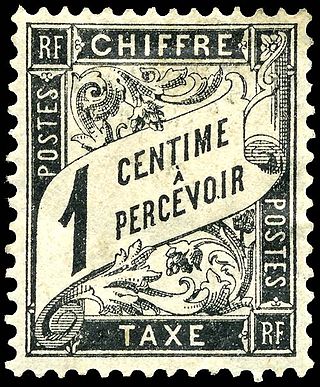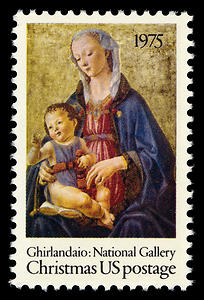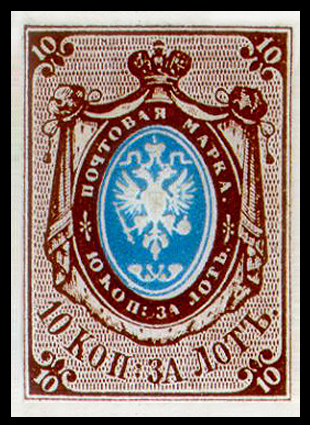
Postage rates in Russia have changed multiple times in the period 1917 to present. They have been introduced by the Soviet and Russian Federation governmental organs and agencies and reflected in alteration of stamp denominations.

Postage rates in Russia have changed multiple times in the period 1917 to present. They have been introduced by the Soviet and Russian Federation governmental organs and agencies and reflected in alteration of stamp denominations.
The issue of Russian postage stamps is directly related to postage rates in force at given times during the history of the Russian postal service. Stamp denominations were applied to meet a public need to pay postage costs according to the current rates. Issuing values for the revenue generation was not a purpose of the state policy in this area. Change of postage rates is an important aspect in studying the Russian postal history and collecting its items. [1]
Russian and especially Soviet postage rates have not been thoroughly researched in philatelic literature. This part of the Russian postal history is less studied, with comments appearing within some other context. Alteration of the postage rates led to the increases in the face value of the stamps as reflected in the numbers printed and overcharged. Thus, the rates were often the reason to revalue current stamps, issue new postage stamps or use various surcharges. [1]
Postal rates for the despatch and delivery of internal mail were changed numerous times. For example, there were about 30 rate changes during the period 1918 to 1966. [1]
Only over the first five years when the Russian Soviet Federative Socialist Republic existed as a sovereign state, from the Bolshevik Revolution in 1917 until the formation of the Soviet Union in 1922, postage rates changed 23 times. The early Soviet post office struggled to keep them up. [2]
Usually, new rates were introduced by special decrees of the Government. In a few cases, this was done by the circularised orders of the postal administration known as "post office circulars". The rates for international postage were established by the same People's Commissariat for Posts and Telegraphs, later superseding by the Ministry of Communications of the USSR. [1]

During the USSR period from 1923 up to 1967, postal rates were changed ten times. Following the RSFSR practice, there was a special supplementary rate in case of registered mail that was added to the normal postage charge. This procedure was in effect until 1948 when a specific rate was established for registered mail. Also, higher rates for special classes of mail existed from 1923 to 1938 that were used for: [1]
An additional fee was charged for sending mail by air. Internal airmail rates were fixed in 1932 and those for international airmail in 1939. From 1936, the airmail rates were applied to regular operations all year round. [1]
For underpaid internal mail, there was a charge at the registration rate. Charge for underpaid international mail was double the deficient postage. [1]
Postal rates were based on the following gradation of letters by weight: [1]

Similar policy and practice of introducing postage rates have been continuing in the Russian Federation since 1992.
This table represents an outline of the overall fluctuations of domestic postal rates in the Soviet and post-Soviet times.
| Years | Postcards | Letters | Registered mail letters | |||
|---|---|---|---|---|---|---|
| Minimum | Maximum | Minimum | Maximum | Minimum | Maximum | |
| Russian Republic, RSFSR | ||||||
| 1917–1923 | 5 kopecks, free of charge [a] | 20,000 roubles [b] | 10 kopecks, free of charge [a] | 50,000 roubles [b] | 20 kopecks | 100,000 roubles [b] |
| USSR | ||||||
| 1923–1991 | 3 kopecks | 25 kopecks | 4 kopecks | 40 kopecks | 6 kopecks | 1 rouble |
| Russian Federation | ||||||
| 1992–2015 | 15 kopecks | 650 roubles [b] | 20 kopecks | 950 roubles [b] | 40 kopecks | 1,100 roubles [b] |

A postage stamp is a small piece of paper issued by a post office, postal administration, or other authorized vendors to customers who pay postage. Then the stamp is affixed to the face or address-side of any item of mail—an envelope or other postal cover —which they wish to send. The item is then processed by the postal system, where a postmark or cancellation mark—in modern usage indicating date and point of origin of mailing—is applied to the stamp and its left and right sides to prevent its reuse. Next the item is delivered to its addressee.

A postmark is a postal marking made on an envelope, parcel, postcard or the like, indicating the place, date and time that the item was delivered into the care of a postal service, or sometimes indicating where and when received or in transit. Modern postmarks are often applied simultaneously with the cancellation or killer that marks postage stamps as having been used. Sometimes a postmark alone is used to cancel stamps, and the two terms are often used interchangeably. Postmarks may be applied by handstamp or machine, using methods such as rollers or inkjets, while digital postmarks are a recent innovation.

An overprint is an additional layer of text or graphics added to the face of a postage or revenue stamp, postal stationery, banknote or ticket after it has been printed. Post offices most often use overprints for internal administrative purposes such as accounting but they are also employed in public mail. Well-recognized varieties include commemorative overprints which are produced for their public appeal and command significant interest in the field of philately.

Postal service in the United States began with the delivery of stampless letters whose cost was borne by the receiving person, later encompassed pre-paid letters carried by private mail carriers and provisional post offices, and culminated in a system of universal prepayment that required all letters to bear nationally issued adhesive postage stamps.

Postal history is the study of postal systems and how they operate and, or, the study of the use of postage stamps and covers and associated postal artifacts illustrating historical episodes in the development of postal systems. The term is attributed to Robson Lowe, a professional philatelist, stamp dealer and stamp auctioneer, who made the first organised study of the subject in the 1930s and described philatelists as "students of science", but postal historians as "students of humanity". More precisely, philatelists describe postal history as the study of rates, routes, markings, and means.

An airmail stamp is a postage stamp intended to pay either an airmail fee that is charged in addition to the surface rate, or the full airmail rate, for an item of mail to be transported by air.

This is a survey of the postage stamps and postal history of the Russian Empire, the Soviet Union and the modern Russian Federation.

Postage due is the term used for mail sent with insufficient postage. A postage due stamp is a stamp added to an underpaid piece of mail to indicate the extra postage due.

Postage stamp design is the activity of graphic design as applied to postage stamps. Many thousands of designs have been created since a profile bust of Queen Victoria was adopted for the Penny Black in 1840; some designs have been considered very successful, others less so.

This is a survey of the postage stamps and postal history of Kazakhstan.
This is a survey of the postage stamps and postal history of Transnistria, an unrecognized breakaway territory of Moldova and the de facto independent Pridnestrovian Moldavian Republic.

Non-denominated postage is a postage stamp intended to meet a certain postage rate, but printed without the denomination, the price for that rate. They may retain full validity for the intended rate, regardless of later rate changes, or they may retain validity only for the original purchase price. In many English-speaking countries, it is called non-value indicator or non-value indicated (NVI) postage. Introduced to reduce the cost of printing large issues of low-value stamps to "top-up" old issues, NVI stamps are used in many countries.

U.S. Special Delivery was a postal service paid for with additional postage for urgent letters and postal packets which are delivered in less time than by standard or first class mail service. Its meaning is different and separate from express mail delivery service. Essentially it meant that a postal packet was delivered from a post office to the addressee immediately once it arrived at the post office responsible for delivering it, rather than waiting for the next regular delivery to the addressee.

This is a survey of the postage stamps and postal history of Estonia. The stamps of Estonia are issued by the postal administration Eesti Post which is the country's only provider of universal postal services.

This is a survey of the postage stamps and postal history of Ukraine.

The 1930 Graf Zeppelin stamps were a set of three airmail postage stamps, each depicting the image of the Graf Zeppelin, issued by the United States Post Office Department in 1930, exclusively for delivery of mail carried aboard that airship. Although the stamps were valid for postage on mail sent on the Zeppelin Pan American flight from Germany to the United States, via Brazil, the set was marketed to collectors and was largely intended to promote the route. 93.5% of the revenue generated by the sale of these stamps went to the Zeppelin Airship Works in Germany. The Graf Zeppelin stamps were issued as a gesture of goodwill toward Germany. The three stamps were used briefly and then withdrawn from sale. The remainder of the stock was destroyed by the Post Office Department. Due to the high cost of the stamps during the Great Depression, most collectors and the general public could not afford them. Consequently, only about 227,000 of the stamps were sold, just 7% of the total printed, making them relatively scarce and prized by collectors.

The U.S. Parcel Post stamps of 1912–13 were the first such stamps issued by the U.S. Post Office Department and consisted of twelve denominations to pay the postage on parcels weighing 16 ounces and more, with each denomination printed in the same color of "carmine-rose". Their border design was similar while each denomination of stamp bore its own distinctive image in the center (vignette). Unlike regular postage items, whose rates were determined by weight in ounces, Parcel Post rates were determined and measured by increments in pounds. The new stamps were soon widely used by industry, farmers and others who lived in rural areas. Partly owing to some confusion involving their usage, their exclusive use as Parcel Post stamps proved short lived, as regular postage stamps were soon allowed to be used to pay parcel postage rates.

Stamps of the Soviet Union were issued in the period 1923 to 1991. They were labeled with the inscription Russian: "Почта СССР". In the thematics, Soviet stamps reflected to a large extent the history, politics, economics and culture of this world's first socialist state.

Definitive stamps of Russia are the regular postage stamp issues produced in the Russian Empire and RSFSR between 1857 and 1923, and in the Russian Federation since 1992.

The first stamp of the Russian Empire was a postage stamp issued in 1857 and introduced within the territory of the Russian Empire in 1858. It was an imperforate 10-kopeck stamp depicting the coat of arms of Russia, and printed using typography in brown and blue.